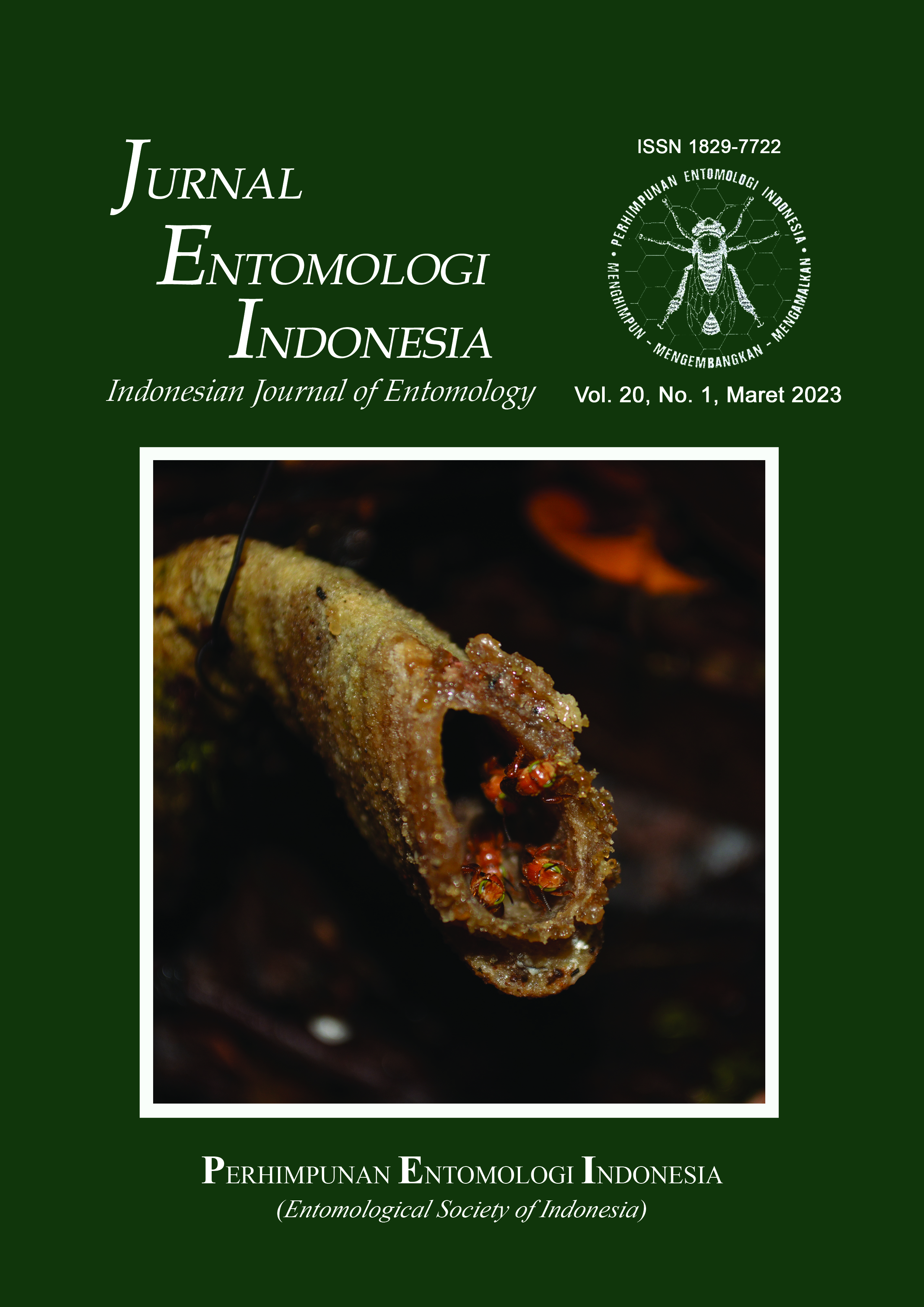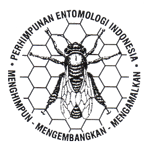Pengendalian lipas jerman (Blattella germanica Linnaeus) dengan menggunakan attractive toxic sugar baits
Control of the german cockroach (Blattella germanica Linnaeus) by using attractive toxic sugar baits
DOI:
https://doi.org/10.5994/jei.20.1.49Keywords:
ATSB (called attractive toxic sugar baits), Blattella germanica, cockroach, controlAbstract
The use of attractive toxic sugar baits (ATSB) is a novelty in vector and residential pest control. This study aims to determine the concentration of sugar bait that is able to attract the german cockroach Blattela germanica Linnaeus, and to determine the effectiveness of various types of toxic substances as an ATSB to control german cockroaches. This method is based on the behavior of adult insects that eat sugars from sources that contain toxic materials and will ultimately kill the insects. The types of toxic materials used in this study were inorganic insecticides (boric acid), pyrrole (chlorefenapir), neonicotinoids (dinotefuran), and pyrethroids (permethrin and deltamethrin). The results showed that an attractive sugar bait for german cockroach was 5% sucrose. ATSB with 25% boric acid toxic material caused 46.25% of cockroach mortality, and 0.12% chlorfenapir caused 70% of cockroach mortality 24 hours after treatment. Furthermore, ATSB with dinetofuran 0.08% and deltamethrin in various concentrations caused the highest cockroach mortality (100%), while permethrin caused cockroach mortality which was lower than ATSB with other toxic materials at the same time of observation. The conclusions of this study provide basic information about the use of ATSB and its potential in controlling the german cockroach in Indonesia.
Downloads
References
Abdullah NAMH, Dom ZC, Camalxaman SN, Yatim SRM, Zainuddin NA. 2019. Assessment of synthetic attractive toxic sugar bait (ATSB) on Aedes albopictus: An experimental design. Malaysian Journal of Medicine and Health Sciences. 15:35–39.
Alias. 2018. Diversitas dan Derajat Infestasi Serangga Pengganggu pada Kapal Laut di Pelabuhan Baubau, Sulawesi Tenggara. Thesis. Bogor: Institut Pertanian Bogor.
Allan SA. 2011. Susceptibility of adult mosquitoes to insecticides in aqueous sucrose baits. Journal of Vector Ecology. 36:59–67. DOI: https://doi.org/10.1111/j.1948-7134.2011.00141.x.
Amin AA, Sollman MH, Shalaby AA. 2017. Evaluation of the efficiency of certain attractive toxic bait for the house fly, Musca domestica (Diptera: Muscidae). Chemical Sciences Journal. 8:1000170.
Az SZN, Hariani N, Trimurti S. 2018. Studi ketertarikan kecoak jerman (Blattella germanica L) pada karbohidrat dari ampas tahu dan ampas kelapa. Bioprospek. 13:12–8.
Brenner RJ, Kramer RD. 2019. Chapter 6 – Cockroach (Blattaria). In: Mullen GR, Durden LA (Eds.), Medical and Veterinary Entomology (Third Edition). pp. 61–77. London: Academic Press. DOI: https://doi.org/10.1016/B978-0-12-814043-7.00006-6.
Chapman RF. 1998. The Insects: Structure and Function. Cambridge: Cambridge University Press. DOI: https://doi.org/10.1017/CBO9780511818202.
Fiorenzano JM, Koehler PG, Xue RD. 2017. Attractive toxic sugar bait (ATSB) for control of mosquitoes and its impact on non-target organisms: A Review. International Journal Environmental Research and Public Health. 14:398. DOI: https://doi.org/10.3390/ijerph14040398.
Gore JC, Schal C. 2004. Laboratory evaluation of boric acid-sugar solutions as baits for management of german cockroach infestations. Journal of Economic Entomology. 7:581–587. DOI: https://doi.org/10.1093/jee/97.2.581.
Gu ZY, He J, Teng XD, Lan CJ, Shen RX, Wang YT, Zang N, Dong YD, Zhao TY, Li CX. 2020. Efficacy of orally toxic sugar baits against contact-insecticide resistant Culex quinquefasciatus. Acta Tropica. 202:105256. DOI: https://doi.org/10.1016/j.actatropica.2019.105256.
Hadi UK, Soviana S. 2010. Ektoparasit: Pengenalan, Identifikasi, dan Pengendaliannya. Bogor: IPB Press.
[IRAC] Insecticide Resistance Action Committee. 2021. IRAC Mode of Action Classification Scheme Version 10.1. Available at: https://irac-online.org/mode-of-action/ [accessed 25 September 2021].
Jiang M, Dong FY, Pan XY, Zhang YN, Zhan F. 2020. Boric acid was orally toxic to different instars of Blattella germanica (l.) (Blattodea: Blattellidae) and caused dysbiosis of the gut microbiota. Pesticide Biochemistry and Physiology. 172:104756. DOI: https://doi.org/10.1016/j.pestbp.2020.104756.
Khallayoune K, Qualls WA, Revay EE, Allan SA, Arheart KL, Kravchenko VD, Xue RD, Schlein Y, Beier JC, Muller GC. 2013. Attractive toxic sugar baits: control of mosquitoes with the low-risk active ingredient dinotefuran and potential impacts on nontarget organisms in Morocco. Environmental Entomology. 42:10405–1045. DOI: https://doi.org/10.1603/EN13119.
Khani AK, Nazari M, Nasirian H. 2020. Insecticide resistance studies on german cockroach (Blattella germanica) strains to malathion, propoxur and lambdacyhalothrin. Chulalongkorn Medical Journal. 64:3575–365.
Kline DL, Muller GC, Junnila A, Xue RD. 2018. Attractive toxic sugar baits (ATSB): A novel vector management tool. In: Norris EJ, Coats JR, Gross AD, Clark JM (Eds.) Advances in The Biorational Control of Medical and Veterinary Pest acd Symposium Series. pp. 645–73. Washington DC: American Chemical Society. DOI: https://doi.org/10.1021/bk-2018-1289.ch005.
Lee CY, Lee LC, Ang BH, Chong NL. 1999. Insecticide resistance in Blattella germanica (L. Dictyoptera: Blattelidae) from hotels and restaurants in Malaysia. In: Wm H. Robinson, Rettich F, Rambo GW (Eds). Proceedings of the 3rd International Conference on Urban Pests. pp. 1715–181. Penang: Malaysia.
Maia MF, Tenywa FC, Nelson H, Kambagha A, Ashura A, Bakari I, Mruah D, Simba A, Bedford A. 2018. Attrative toxic sugar baits for controlling mosquitoes: A qualitative study in Bagamoyo, Tanzania. Malaria Journal. 17:22. DOI: https://doi.org/10.1186/s12936-018-2171-2.
Mitsui Chemical. 2021. Dinotefuran. Availabe at: https://us.mitsuichemicals.com/service/product/dinotefuran.htm. [accesed 25 September 2021].
Pai HH, Wu SS, Hsu EL. 2010. Insecticide resistance in german cockroaches (Blattella germanica) from hospitals and households in Taiwan. International Journal of Environmental Health Research. 15:33–40. DOI: https://doi.org/10.1080/09603120400018816.
Qualls WA, Muller G, Revay E, Allan SA, Arheart KL, Beier JC, Smith ML, Scott JM, Kravchenko VD, Hausmann A, Yefremova ZA, Xue RD. 2014. Evaluation of attractive toxic sugar bait (ATSB)-barrier for control of vector and nuisance mosquitoes and its effect on nontarget organisms in sub-tropical environments in Florida. Acta Tropica. 3:104–110. DOI: https://doi.org/10.1016/j.actatropica.2013.12.004.
Qualls WA, Florenzano JD, Muller G. Arheart KL, Beier JC, Xue RD. 2016. Evaluation and adaptation of attractive toxic sugar baits for Culex tarsalis and Culex quinquefasciatus control in the Coachella Valley, Southern California. Journal of the American Mosquito Control Association. 32:292–299. DOI: https://doi.org/10.2987/16-6589.1.
Rahayu R. 2012. Present status of carbamate, pyrethroid and phenylpyrazole insecticide resistance to german cockroach, Blattella germanica (Dyctioptera: Blattellidae) in Indonesia. Journal of Entomology. 9:361–367. DOI: https://doi.org/10.3923/je.2012.361.367.
Rafiuddin AT. 2016. Telaah Infestasi Lipas (Insecta: Dictyoptera) pada Bus dan Kaitannya dengan Pengelolaan Moda Transportasi. Thesis. Bogor: Institut Pertanian Bogor.
Shahraki GH. 2013. Evaluation of sanitation in an IPM program for cockroach infestation in housing. Journal of Macro Trends in Health and Medicine. 1:58–62.
Sheih A, Parks WC, Ziegler SF. 2017. GM-CSF produced by the airway epithelium is required for sensitization to cockroach allergen. Mucosal Immunology. 10:705–715. DOI: https://doi.org/10.1038/mi.2016.90.
Shin E, Park C, Ahn YJ, Lee DK, Chang KS. 2011. Insecticidal and repellent activities of insecticide–sucrose solutions to Culex pipiens molestus (Diptera: Culicidae) under laboratory and field conditions. Pest Management Science. 67:665–671. DOI: https://doi.org/10.1002/ps.2106.
Sinulingga JB. 2020. Infestasi Lipas (Insecta: Dictyoptera) dan Keterkaitannya dengan Pelaksanaan Biosekuriti pada Rumah Sakit di Kota Palangkaraya Provinsi Kalimantan Tengah. Thesis. Bogor: Institut Pertanian Bogor.
Song M, Wang B, Liu J, Gratz N. 2003. Insect vectors and rodents arriving in China aboard international transport. Journal of Travel Medicine. 10:241–244. DOI: https://doi.org/10.2310/7060.2003.40603.
Stewart ZP, Oxborough RM, Tungu PK, Kirby MJ, Rowland MW, Irish SR. 2013. Indoor application of attractive toxic sugar bait (ATSB) in combination with mosquito nets for control of pyrethroid-resistant mosquitoes. Plos One. 8:e84168. DOI: https://doi.org/10.1371/journal.pone.0084168.
Supriyanto A. 2018. Faktor Risiko Infestasi Serangga Pengganggu dan Potensinya sebagai Vektor Salmonellosis pada Kapal Laut di Pelabuhan Baubau Sulawesi Tenggara. Thesis. Bogor: Institut Pertanian Bogor.
Wirawan IA. 2006. Insektisida Permukiman. In: Sigit SH, Hadi UK (Eds.), Hama Permukiman Indonesia. pp. 315–433. Bogor: IPB Press.
Xue RD, Kline DL, Ali A, Barnard DR. 2006. Application of boric acid baits to plant foliage for adult mosquito control. Journal of the American Mosquito Control Association. 22:497–500. DOI: https://doi.org/10.2987/8756-971X(2006)22[497:AOBABT]2.0.CO;2.
Downloads
Published
How to Cite
Issue
Section
License
Copyright (c) 2023 Fahmi Khairi, Upik Kesumawati Hadi, Akhmad Arif Amin

This work is licensed under a Creative Commons Attribution 4.0 International License.
Authors who publish with this journal agree to the following terms:
- Authors retain copyright and grant the journal right of first publication with the work simultaneously licensed under a Creative Commons Attribution 4.0 International License that allows others to share the work with an acknowledgement of the work's authorship and initial publication in this journal.
- Authors are able to enter into separate, additional contractual arrangements for the non-exclusive distribution of the journal's published version of the work (e.g., post it to an institutional repository or publish it in a book), with an acknowledgement of its initial publication in this journal.
- Authors are permitted and encouraged to post their work online (e.g., in institutional repositories or on their website) prior to and during the submission process, as it can lead to productive exchanges, as well as earlier and greater citation of published work (See The Effect of Open Access).








